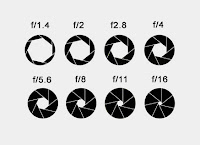 Aperture
ApertureA change in the aperture effects the amount of light that is received by the sensor and therefore the amount of light within a still image. To adjust the amount of light in an image, say perhaps a scene is too dark, opening/increasing the aperture will result in a brighter scene. Doubling the aperture quadruples the exposure. Aperture sizes are measured in f-stops (the size of the aperture reduces the depth of field). There is another factor that will effect the amount of light let into the image: the lens. A larger aperture is needed for a 100 mm lens and hence a smaller one is needed for a 50 mm lens for example to achieve the same result.
 Shutter Speed
Shutter SpeedThe shutter is like a small curtain in a camera. It quickly passes over the image sensor and thus only allows light to enter and be absorbed by the sensor for fractions of a second. The faster the shutter passes over, the dark the resulting image. Therefore a lighter image can be created by reducing the shutter speed. A shutter speed of 1/20 of a second for example, will allow more light into the sensor than a shutter speed of 1/40. The shutter in a digital camera is also primarily responsible for effecting the amount of blur in moving imagery. By increasing the shutter speed, the image is being taken so fast that the object in movement has travelled less distance for any blur to be noticeable in a picture.
 ISO
ISOISO (International Organization for Standardization) is the software setting on a camera that will dictate how sensitive your camera's sensor is to light. Increasing the ISO will result in a brighter picture, however it also has an unfortunate drawback of creating more noise in an image. The amount of noise desired in an image can be a preference of choice as this can on the other hand make an image appear more like traditional grainy film photography.
No comments:
Post a Comment